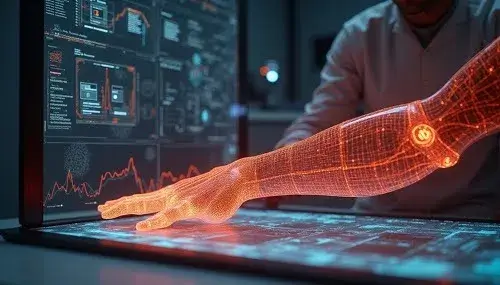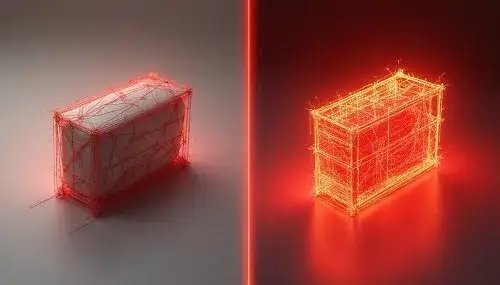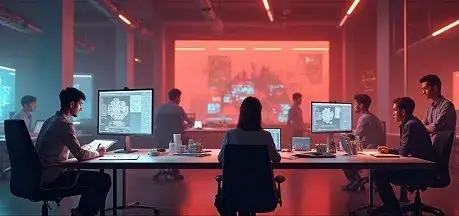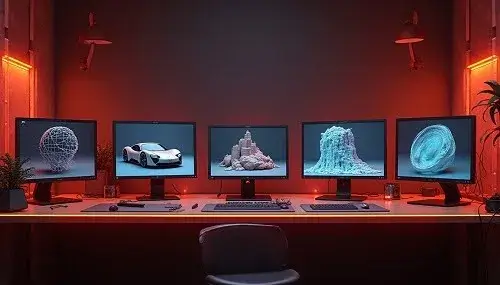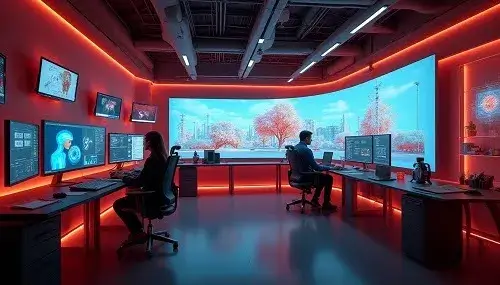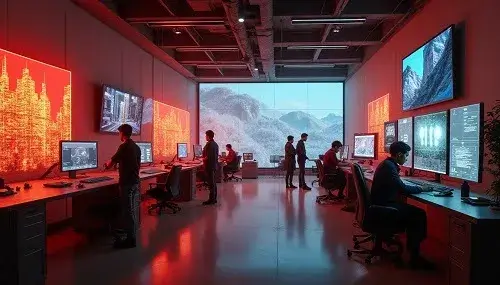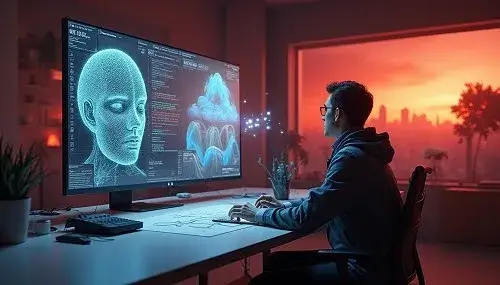Ever looked at a movie monster so real it gave you chills? Or scrolled past a furniture ad that showed you exactly how that couch would look in your living room? That’s 3D modeling at work. But the question of what is 3D modeling still confuses a lot of people.
It’s not just for game designers and VFX teams anymore. Within the next two years, entire industries will begin adopting 3D modeling, allowing prosthetics to fit more seamlessly, as well as virtual stores with “try before you buy” features.
“3D modeling” is a phrase that our society is beginning to understand, and the opportunities it exposes can serve the interests of many, including brands and everyday problem solvers alike. That’s why brands and businesses are seeking top-notch 3D modeling services frequently.
According to one report, the 3D modeling industry will hit a market value of 40 billion USD by 2033. This shows a CAGR of 16.06% during the 2025-2033 time period.
This is not a vague text intended to explain 3D modeling as a textbook. This guide covers the 3D model’s history, its applications, tools, and its future with the help of candid opinions and simple step-by-step descriptions.
So, What is 3D Modeling Exactly?
Essentially, 3D modeling is the process of creating a digital representation of an object with its dimensions using 3D modeling software. However, consider the object a digital model rather than a flat sketch on paper.
When illustrating 3D modeling, as in “What is 3D modeling?” And, as many people ask, it does revolve around converting imaginary and real objects to 3D.
This is a two-step process of working “backwards” that includes moving points, also known as vertices, in a three-dimensional coordinate system to form shapes and polygons, before morphing into a mesh or skeleton of an object.
From Pixels to Full-Blown 3D Modeling
3D modeling didn’t show up overnight. Back in the 60s, it was mostly academic, think engineers plotting shapes with Ivan Sutherland’s Sketchpad. Fast-forward to the 90s, Pixar pushed animation into the mainstream. The 3D modeling industry exploded once graphics cards got better, software improved, and artists could actually handle heavy scenes on a laptop.
Any student using a laptop and free 3D modeling software, such as Blender, can create detailed scenes in a fraction of the time a studio would have taken a decade ago.
How the 3D Modeling Process Works
There’s no single rulebook for creating a 3D model, but every project hits the same checkpoints.
1. Concept & Planning:
It all starts with an idea, maybe it’s a new product prototype or an alien creature for a sci-fi game.
2. Blocking & Sculpting
Artists shape the basic structure using simple geometry. This is when you get the rough silhouette down.
3. Detailing the Mesh
Once the shape’s locked in, it’s time to add details. Extra vertices, refined edges, this step turns blocks into believable forms.
4. Texturing & Materials
Textures bring color, bumps, scratches, and reflections to the surface. A plain mesh won’t look real until it gets its skin.
5. Lighting & Rendering
The way lights give an object its depth and appearance from different angles determines how it is viewed. Rendering is the process of compiling all the information into the final product.
6. Final Export & Use
The finished model might go into a game engine, a VR simulation, or even a 3D printer.
Basic 3D Modeling Principles You Can’t Skip
No matter how fancy the 3D modeling software gets, the basics stay the same.
Topology Matters: A clean and structured mesh topology is easier to edit and animate, resulting in smoother final rendering.
Scale & Proportion: When the object needs to interact with the real world, it is important to adhere to real-world measurements.
Polygon Count: While more detail is added with increased polygons, balance is a vital aspect, as an excessive amount will crash the project.
Lighting & Textures: These give life to your mesh. A well-textured model with good lighting beats a complex but plain mesh every time.
Common 3D Modeling Examples
Most people don’t realize they see 3D modeling everywhere.
Movies & Games: Each creature, spaceship, or fantasy landscape is initially envisioned as a 3D model.
Architecture: The creation of realistic urban designs involves 3D models, which also enable interactive and accurate virtual tours alongside the provided floor plans.
Product Design: A 3D showcase is created before the real-life prototype is manufactured by brands.
Medical Fields: 3D models are tailored to aid doctors in planning surgeries or developing prosthetics. You can further explore medical animation studios if that is what you are specifically interested in.
Marketing & Ads: High-end visuals, digital twins, and AR filters? All built on 3D models.
What Are the Different Types of 3D Modeling?
One size doesn’t fit all. The 3D modeling industry has dozens of specialties, but here are the biggest:
1. Polygonal Modeling
The most common type. Artists build surfaces using connected polygons. Great for games and animation because it’s flexible and relatively easy to edit. Companies that provide game trailer services often incorporate this technique into their own creations as well.
2. NURBS Modeling
Stands for Non-Uniform Rational B-Splines. Instead of flat polygons, these use curves. Better for precise, smooth surfaces like car bodies or industrial designs.
3. Digital Sculpting
Think clay, but digital. Artists push, pull, and smooth a virtual lump into complex characters or organic shapes. ZBrush is a favorite for this.
4. Procedural Modeling
This new type of 3D modeling uses algorithms. Artists set rules, and the software generates shapes automatically, handy for creating massive terrains or cityscapes.
5. 3D Scanning
Sometimes, it’s easier to scan a real object. The scan becomes a base mesh that artists refine for games when offering full–fledged game animation services, VR, or archival purposes.
Popular 3D Modeling Programs in 2025
The toolkit keeps growing, but a few 3D modeling software options still lead the pack:
Blender: Open-source, community-driven, handles everything from sculpting to VFX.
Maya: The big gun for Hollywood studios, known for animation pipelines.
3ds Max: Used for games, architecture, and VFX.
ZBrush: The gold standard for digital sculpting.
Rhino: Best for industrial and product design.
Fusion 360: Combines CAD and CAM, popular for engineers and makers.
These tools keep adding features that make the 3D modeling process smoother, faster, and more flexible.
Why 3D Modeling Technology Keeps Expanding
Every year, new technologies are introduced, such as AI and VR, and by 2025, the industry will not only focus on appealing visuals but also address challenges like designing safer vehicles, evaluating climate change, and developing VR simulations for surgical training.
Generative AI is changing how we build meshes. Real-time rendering is speeding up workflows. And with AR filters and VR headsets going mainstream, 3D assets are becoming everyday media.
The 3D Modeling Industry
The 3D modeling industry is no side hustle; it’s a serious sector. It’s a full-scale powerhouse, feeding into film, gaming, architecture, product design, and healthcare. The 3D modeling market currently has a value in the billions and is expected to continue growing.
To stay competitive in the market, businesses and creators require top-tier visuals, augmented and ready models, and hyper-realistic prototypes.
3D modeling enables architects to showcase multi-million-dollar projects and indie game developers to build games in coffee shops, pushing the concept from screen to shelf. Sustained growth over the next decade is highly likely with increasing demand for detailed, optimized, and interactive models.
3D Modeling Technology
3D modeling technology is more than a tool; it’s become a backbone for industries looking to communicate, sell, and create effectively.
Entertainment and Gaming
Movie studios, gaming companies, and VR companies rely on 3D modeling to create visual effects, characters, and immersive interactive spaces. With proper 3D modeling, studios have the capability to create characters, environments, and props that can move easily and switch between animation and real-life interactivity.
Architecture and Real Estate
Walkthroughs are no longer blueprints on paper. Potential clients can take virtual tours of unbuilt spaces. 3D modeling helps architects test structural ideas and aesthetics without wasting resources on physical models.
Healthcare and Medical Training
Doctors create customized 3D models of prosthetics, surgical plans, and educate patients. Advanced models of anatomy are used in medical simulations to assist trainees and experts in the safe practice of complex procedures.
Product Design and Manufacturing
Designers can use 3D modeling to test, refine, and visualize a product before moving on to the expensive prototype phase. Designed models can be subjected to virtual stress tests, their aesthetics altered, and the model checked for real-world compatibility.
Marketing and Advertising
Brands can leverage 3D modeling technology to animate products, create augmented reality previews, and generate more engaging advertisement visuals. Through the interactive 3D model, customers will also be able to view the products through rotational inspection, especially for e-commerce.
Branches of 3D Modeling
When you look deeper into what is 3D modeling, you find many specialties that match different industries and interests.
Architectural Modeling
Architects, as well as interior designers and urban planners, branch out into this field by creating more sophisticated models of the structures and even the city blocks. It aids in simulating projects for customers and accurately testing materials and lighting.
Product and Industrial Design Modeling
Designers can develop and modify digital prototypes of shoes and cars before they are produced. This model also encompasses the creation of promotional marketing materials, which involves designing 3D models.
Character and Creature Modeling
This branch is essential for film and video games, focusing on the creation of stylized or realistic characters and creatures. Artists build the anatomy and texture, and rig them for animated motion.
Scientific and Environmental Modeling
In biology, 3D modeling facilitates the visualization of complex data, including molecular models, three-dimensional geological simulations, and the conversion of data into visual representations. Scientists who simulate phenomena and explain concepts in a simpler manner also fall under this category.
Environmental and Landscape Modeling
Used for video games, films, and VR, this type creates forests, oceans, and cityscapes. Procedural generation and sculpting techniques build large environments without compromising detail.
Joining 3D Modeling Communities
Thanks to active 3D modeling communities, artists have more opportunities to share and learn, receive feedback, and stay inspired, which helps them develop their skills more quickly.
Popular 3D Modeling Communities:
Blender Artists Community: This community is designed for collaborative artists who use Blender. As such, they are able to exchange experiences, resolve challenges, and offer and receive critiques.
CG Society: Hosts global challenges and showcases for artists across various 3D modeling software.
Polycount: Focuses on game artists, providing feedback and community competitions.
CG Architect: Tailored for architectural visualization professionals.
RenderHub and Sketchfab: To share, sell, and learn from other artists’ 3D models.
Autodesk Area: Specialized forums and resources for Maya and 3ds Max users.
Joining a community can provide faster solutions, facilitate exposure, and assist in networking in the 3D modeling sphere.
3D Model Marketplaces
Today, selling 3D models can be an income source for numerous artists. These marketplaces help you to sell your creations and the buyers to purchase ready-made assets.
Top 3D Model Marketplaces:
TurboSquid: Famous for a vast selection of high-quality models for film, gaming, and advertising.
CGTrader: Supports free and paid models, with an active community and contests.
Sketchfab: Lets artists showcase and sell models while allowing real-time 3D previews.
3DExport: Offers models across categories with a clear seller platform.
Shapeways: Has 3D printing capabilities, which allows customers to order physical prints of your designs.
One can build their reputation and design passive income by participating in these platforms.
AI in 3D Modeling
AI is developing a new type of 3D modeling that combines traditional skills with automation and smart assistance.
How AI Enhances 3D Modeling Technology
AI can:
Speed up the 3D modeling process by automating repetitive tasks.
Generate mesh suggestions based on reference images.
Create realistic textures and materials from photos.
Assist with procedural generation for large environments.
Benefits and Limitations
AI helps in many ways, such as boosting creativity and automation, but it cannot replace an artist’s imagination, context, and design. It’s a tool to supplement, not supplant, the artistic vision.
Quick Wins for Learning 3D Modeling
Start your 3D modeling journey here if you wish to begin it in 2025:
Choose one modeling software, and familiarize yourself with its interface.
Understand the foundational principles such as topology, proportion, and scale.
Analyze common modeling case studies to gain an understanding of 3D modeling theory.
Take a modeling course to join a community that gives and receives support and feedback.
Begin with smaller scenes before attempting larger ones to refine your skills through regular practice.
Understand 3D modeling marketplaces so as to know what to sell and why.
Future of 3D Modeling Technology
What is 3D modeling in 2025 without looking ahead? The future holds fewer fantastical predictions and more practical, real-world shifts that are currently transforming the 3D modeling world.
Virtual Reality and Augmented Reality Integration
Presently, 3D modeling integrates seamlessly with VR and AR workflows. Architects can offer VR interactive walkthroughs, during which product designers can ergonomically evaluate items in AR without needing physical prototypes. These workflows will become commonplace in various fields, enhancing precision and saving time.
Generative Design and AI Assistance
AI generative design captures attention in product design and engineering. Artists establish rules, such as weight, material, and functionality, and the system generates optimized design variations based on these. This does not negate imagination; it enhances efficient creative thinking.
3D Printing and Rapid Prototyping
The pairing of modern 3D printing technology with sophisticated models enables efficient workflows in rendering designs. Surgical models are created by medical professionals, designers physically replicate samples for clients, engineers print test parts, and everything can be done in-house within days. It optimizes the loop of modeling and testing, and refining.
Real-Time Rendering
Forget overnight renders. Artists can visualize their work as they collaborate with the material and lighting, and animate in real-time. This preserves the creative workflow and accelerates approvals for revisions and the final product.
Frequently Asked Questions
What is 3D modeling, and why is it important?
3D modeling is the process of creating a virtual representation of real-world objects and assets using specialized tools and software. It facilitates product visualizations, enables the creation and construction of virtual worlds, and ensures effective cross-industry communication.
Which 3D modeling software is best for beginners?
With no cost and great versatility, Blender serves as a kind of starting point. ZBrush is ideal for those who want to focus on sculpting, while SketchUp is well-suited for architecture.
How long does it take to learn 3D modeling?
Attaining core skills through consistent practice can be achieved within 3-6 months, while full mastery is dependent on focus and practice and can take several years.
What industries use 3D modeling technology?
3D modeling is widely adopted across various industries, including education, marketing, medicine, film, gaming, and architecture.
How do I choose between different 3D modeling programs?
Considering the objectives, the focus can be adjusted to utilize Blender for all-around sculpting, ZBrush for precision modeling, and 3ds Max for architecture and VFX. For a more comprehensive approach, Blender can be used initially, followed by ZBrush for precision modeling and Maya for animations.
Is 3D modeling a good career?
Yes. The 3D modeling industry continues to grow, offering opportunities in film, gaming, architecture, and advertising.
What skills do I need for 3D modeling?
Artistic skills for design and aesthetics, technical skills for software handling, and problem-solving abilities for creative challenges.
Final Word
You now understand what is 3D modeling in a practical, industry-relevant way. This isn’t just a creative hobby. It’s a tool that helps brands sell, creators build, and businesses thrive.
At Prolific Studio, one of the best animation studios in Colorado, we don’t just create 3D models; we craft experiences that help your ideas shine and sell. Whether you need architectural walkthroughs, product animations, or lifelike character models for your game, our team delivers assets that perform and impress.
Ready to elevate your projects with professional 3D modeling services? Contact Prolific Studio today and let’s bring your vision into a vivid, impactful reality.
Related Article:

